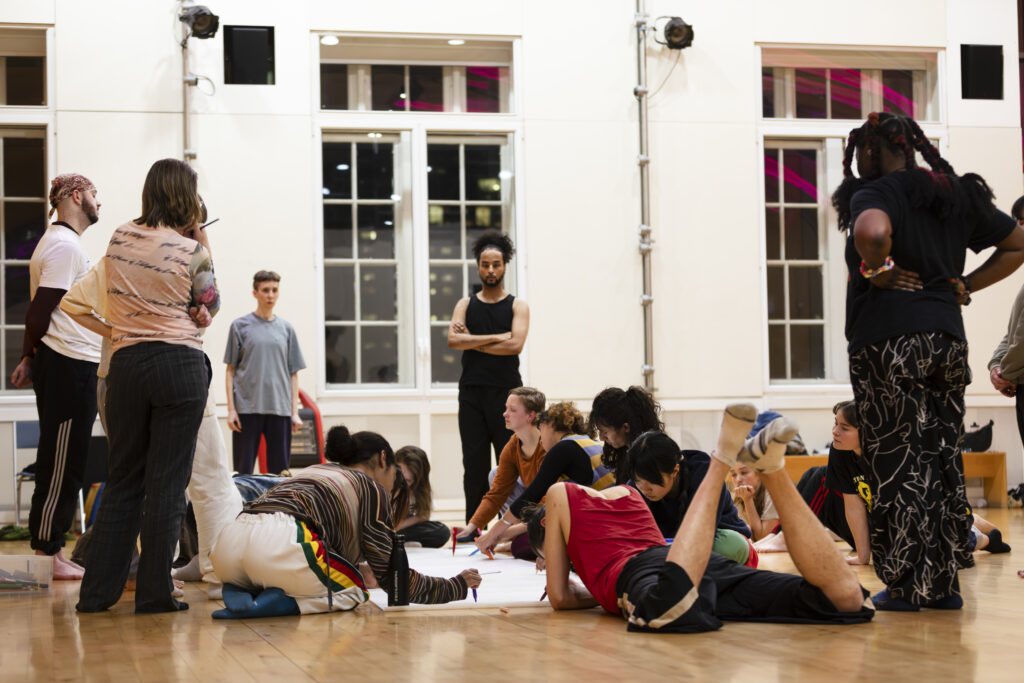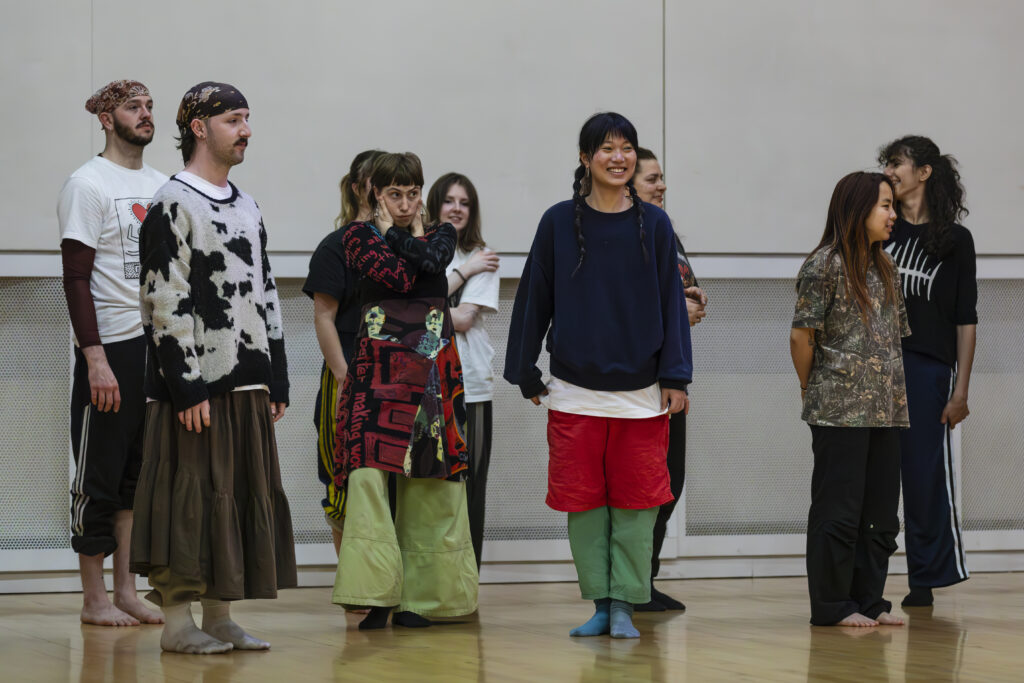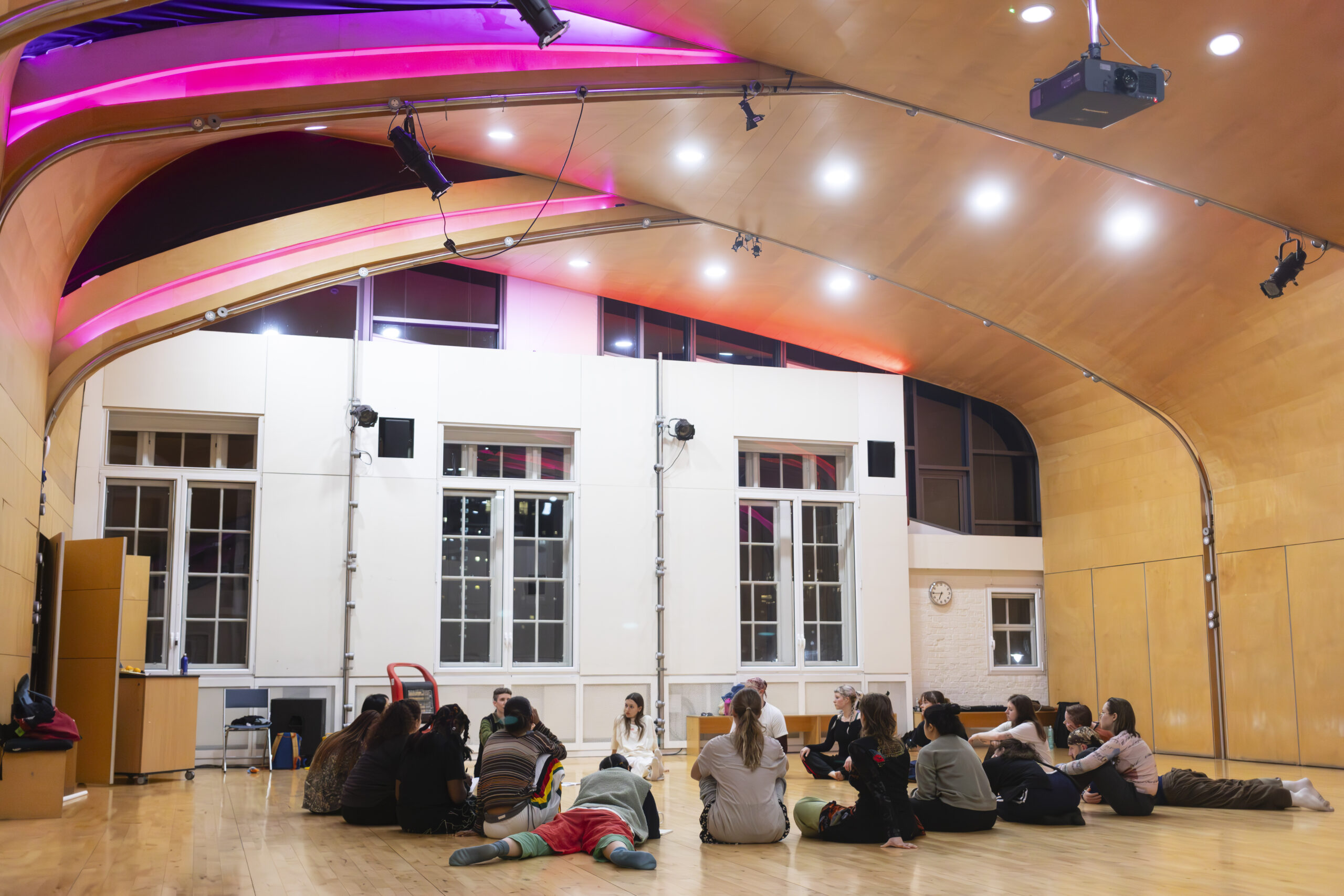Words by Florence Nicholls.
When we think about dance education, what might come to mind is a dimly lit studio, ill-fitting leotards and gruelling exercises. Or maybe, romantically, the pursuit of a life-long dream to take the stage. Oftentimes, it is thought that the way to enter dance spaces is to have already been there since childhood. Encouragingly, there are increasing opportunities for people to contribute to dance culture, beyond the traditional conservatoire training. Siobhan Davies Studios offers a six month programme, NEXT, as a collaborative platform designed for young people aged 18-25, with or without previous dance experience, who are dedicated to cultivating a movement practice.
This year’s cohort is currently into their second term, developing work to be presented at their self-choreographed and curated festival on 22-23 March. Ahead of the gathering, Dance Art Journal attended a sharing where ideas were fresh in the studio and there was a quiet vulnerability floating overhead as the session began.
Created at Siobhan Davies Studios, NEXT is a ‘collaborative learning space’ held by Artistic Director Annie Pui Ling Lok and Producer Nancy May Roberts. Since the mid 2000s, Siobhan Davies Studios has continued to cultivate a collaborative ethos, working closely with visual artists and designers to reflect the culture’s widening lens on the performing arts. The studios have been host to genre bending works such as Jemima Hoadley’s collaboration with photographer Camilla Greenwell for the exhibition entitled, I Am Not Static, shown in 2023. Siobhan Davies Studios is also dedicated to providing a broad variety of workshops and classes for the community, with sessions lead by dance artists including Adesola Akinleye, Freestylers or LANGUAGE POWER FEAR EMOTION. NEXT is an extension of the studio’s multidisciplinary praxis, inviting a limitless array of artistic practices to be developed that hinge on movement as an active form of communication.
In the first term NEXT had the opportunity to work with visiting dance artists which over the years have included Seke Chimutengwende, Orrow Bell and NEUROLIVE. This year the cohort have worked with Freestylers, SERAFINE 1369, Sasha Shadid, Stephanie McMann, Shannelle Tali Fergus, Sara Sassanelli, Anna Seymour, Angela Andrew, Jules Cunningham and Liz Aggiss. Currently, NEXT are putting their own projects into motion, taking inspiration from a spectrum of creative practices. There was an eclectic quality to the sharing that reflected the cohort’s multidisciplinary background. Not limited to ‘contemporary dance aesthetics’, the artists’ contributions had complex identities that reflect what it means to build a personal creative practice, rather than to be moulded by institutional techniques.

At 6:30pm, the NEXT cohort filtered into Siobhan Davies Studios for their weekly session. Under the curved ceiling of the roof studio, conversation circulated amongst the group; notebooks were at the ready and though the sharing began with some hesitation, encouragement and joyful engagement held the tone throughout.
After joining in the centre of the space, the cohort were reminded, ‘this is not a crit’, a form of sharing that tends to dominate in certain facets of arts education and often invites the brash critic to centre stage. Instead, the NEXT cohort naturally formed a democratic circle around the studio. As they offered perspectives and formulated insightful references, a web of connecting interests wove the artists and their projects together.
The sharing took place over two and a half hours. Pieces and conversations were presented in the round, occasionally shifting across the studio or to turning our heads to the doorway where Jemima Pike navigated the liminal space between the hallway and an open room, headphones on and telling a loose-ended story. Then, to the back of the space where Roisin Billeter arranged stone formations with an air of ancient wisdom.
Later in the session, we moved to the corner of the studio to watch choreographer Qiao Lin Tan’s piece, presented under the working title, Giselle waits in her coffin offstage for the other Willis to finish dancing so that she can be summoned on for her solo. Taking inspiration from the famed ballet, Giselle, originally performed by Carlotta Grisi, Qiao conceptualised a jaded prima, awaiting her return to the stage as a vengeful spirit bride, impatient and fidgeting in her prop coffin. Qiao lay perfectly still, covered by a thin stretch of fabric before sighing in frustration. Her exhale was accentuated by the moveable fabric, forming a lifted veil over her face. Qiao’s comedic timing was already exceptional, bluntly posing to the group before the performance, “How long could you watch this?” After the presentation, responses came in rippling agreement. “Push it further!”, “I could just keep watching!” and “let it go on!” replied the group with earnest encouragement.
The explorations of physical theatre during the session recalled aesthetics from across the genre, from Butoh, to the contemporary ventures of DV8. Other offerings included group improvisations, original sound compositions, movement scores and expressive choreographies that tied together disparate references both personal and academic. It was energising to be present amongst such passionate individuals, untangling esoteric knowledge, committed to the communication of complex and personal proposals.
Sam Smith is currently making a verbatim dance theatre show about transness and ballet, more specifically, people who have trained in classical ballet. Sam highlights, “There is such a gender role in ballet and a gendered body binary.” Their process involves taking interviews with trans and gender nonconforming people, presenting staged research and using the structure of a ballet class to frame the performance. Sam seems to be taking an anthropological approach to their choreographic research, influenced by their prior experience in the field, having studied ballet and contemporary dance for 15 years before breaking away from performing. Their project has been in the making since 2023 and NEXT is where Sam has chosen to develop their work in an encouraging and intensive environment.

On the 22nd and 23rd of March, NEXT will take over the Siobhan Davies site, presenting a multiplicity of performances. For some of the cohort, NEXT is their opportunity to hone a practice that is years in the making. For others, attending the course marks their introduction to the world of performance and choreography.
There was a strong feeling of community amongst this year’s group of young artists. By taking part in NEXT, they join the programme’s tight-knit alumni, including several who are currently working in the industry and a fateful few of the Dance Art Journal team who met on the programme.
Whilst dance education and the wider industry has begun to diversify, moving away from the rigid and unattainable model of the professional dancer, there is a way to go before the collective realisation of the expression, ‘everybody can dance’. By prioritising interest over experience, the NEXT programme is an experimentation in what dance education could look like once the standard for premature success is removed, and instead encourages young artists to continue to play on, like there is no destination in sight.
For more information about NEXT and to book visit: https://www.siobhandavies.com/events/fest-next-25/
